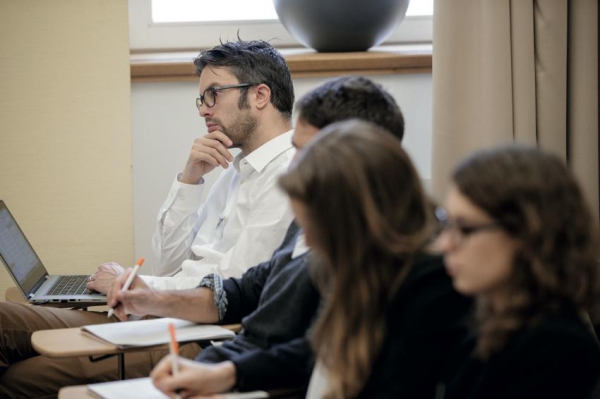Microfinance response to the refugee crisis
- Edvardas BUMSTEINAS, EIB
- Alia FARHAT, Al Majmoua (Lebanon)
- Jasmina GLISOVIC, Council of Europe Development Bank
- Resi JANSSEN, Cordaid
- Silke MUEFFELMANN, Frankfurt School of Finance & Management
PRESENTATIONS
Edvardas BUMSTEINAS welcomed the audience and speakers and said that the current refugee crisis questions the appropriateness of policy responses. Since many refugees are potential microfinance clients, the aim of the session was to identify appropriate areas and responses of microfinance to the current refugee crisis.
Alia FARHAT from the leading Microfinance Institution in Lebanon, the Lebanese Association for Development - Al Majmoua, presented her experiences from the field. Lebanon experienced a rapid influx of Syrian refugees over the last years, from around 25,000 in June 2012 to over 1.5 million registered in June 2015. The NGO has financial and non-financial services in place to deal with this influx of refugees; focusing especially on building the entrepreneurial capacities of women and youth. One pilot uses group lending methodology for mixed groups of Syrian and Lebanese, with the aim to increase social cohesion. In addition, the NGO has several non-financial services in place. The largest include trainings on financial education, on technical skills and vocational trainings and social cohesion activities between Lebanese and Syrian refugees. Farhat stated that traditional aid architecture has reached its limits. There is a need to build a resilience agenda for both the refugees and host countries. Financial resources play an important role and mechanisms include encouraging international investment in host countries to boost the economy, developing infrastructure in the host countries to help absorb the load of influx and develop local MSMES to help job creation for both Syrians and Lebanese.
Resi JANSSEN explained how Cordaid uses three approaches for their work with refugees. Firstly, Cordaid provides relief support to refugees in conflict areas, neighbouring countries and along the roads to Europe. Secondly, Cordaid supports the creation of social cooperatives for refugees in the Netherlands to strengthen their socio-economic participation. Cordaid provides these cooperatives with legal advice, training, coaching, linkages to financial services and exchange of experiences. Finally, in cooperation with the Stability Impact Fund, Cordaid invests in MFIs, SMEs and funds in fragile countries to stimulate entrepreneurship and job creation in order to prevent migration in the first place.
Jasmina GLISOVIC, Country Manager at the Council of Europe Development Bank (CEB), explained that CEB works with a wide range of institutions to help solve social problems that occur as a result of the presence of refugees, displaced persons or migrants in Europe. She stressed that there is a need for holistic approaches - from immediate assistance to integration. For emergency support, CEB created the Migrant and Refugee Fund to help countries most affected by the massive inflow of migrants and refugees, for example by helping to set up registration centres. For long-term integration in host countries, CEB used a combination of different support services focusing on social housing, education, job creation and microcredit. For the latter, one of the main challenges is the identification of MFI partners which are able to reach refugees / migrants with adequate services and credit risk.
Silke MUEFFELMANN of the Frankfurt School of Management & Finance provided lessons learned from various projects worldwide. She evaluated the importance of different actors in both fragile states and host countries, from the perspective of the client. The importance of actors differs in host countries and in fragile states. While banks and MFIs have a role to play in both, relief organisations such as Cordaid, have a bigger role to play in fragile states than in Europe. Also international financial institutions and the international donor community should make sure that more financial resources and funding flow to fragile states, since Europe has the economic power, sufficient financial resources and the experience with integration to deal with the inflow of refugees.
DISCUSSION

Bumsteinas asked Farhat to expand the idea of social cohesion and the importance to target both refugees and the host community. Farhat explained that usually 4 to 5 sessions were needed to build the necessary trust for group lending. Therefore financial services were only provided after the non-financial services. Bumsteinas asked Mueffelmann to explain the surprising factor that relief organisations are not needed in Europe. Mueffelmann explained that Europe has the necessary financial systems and funds and that it is rather a political decision if these funds will be relocated to respond to the refugee crisis. Glisovic added some complexity to Mueffelmann’s statement that Europe can manage the refugee crisis. She stated that countries in Europe have divergent perspectives on the refugee crisis and also have different economic and financial situations, which complicates the situation.
Niclaus Bergmann from the Savings Banks Foundation for International Cooperation (SBFIC) drew attention to the practical issues of the refugee crisis. With approximately 500,000 refugees to open a bank account in Germany by the end of the year, practical issues that have to be dealt with include the lack of capacities in branches, language barriers, and financial illiteracy of the refugees. Farhat agreed and explained that their services therefore focus on the capacity building of staff members to better deal with refugees.
Mueffelmann responded to a question about the importance of informal finance services. She stated that it is rather important to find innovative ways within the formal financial sector to serve refugees. New delivery channels such as mobile phones could play an important role. Farhat concluded the discussion by addressing the legal issues with refugees. In Lebanon, Syrian refugees only receive working permits in a few sectors, including construction, cleaning and agriculture. This shows that microfinance has a role to play in developing other innovative income generating activities, but that macroeconomic solutions are also needed. Bumsteinas agreed that microfinance has a role to play in the refugee crisis, but that it also has certain limits.
